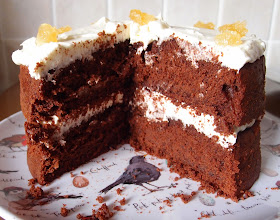Mr
CC’s workplace is hosting a big coffee morning for Macmillan Cancer on Monday in order to give
everyone time to bake over the weekend rather than have to do it when they got
home from work. I’ve been beavering away making sponge cake and cupcakes
and needed something very quick and easy for us to enjoy. Cake for
charity is an extremely worthwhile and noble thing but there’s also the saying
that charity begins at home so I knew our own cake tin had to be well stocked
too!
This
really couldn’t be any quicker or easier. Or any more delicious which,
after all, is obviously the most important thing. I am always partial to
anything oaty – I’ve never met a flapjack I didn’t like, but the addition here
of chocolate and peanut butter raises the bar and adds that salty-sweet element
that everybody seems to adore. The
molten chocolate peanut butter mix was so glossy and beautiful that I had to
photograph it:
The only tricky thing here is not to eat all the warm, buttery oat mix before it finds its way to the pan to chill. Warning: do not taste a bit ‘just to see what it’s like’. You will end up eating a pan full of warm oats and wondering if you have enough ingredients left to make a second batch! I tasted a bit (which I realise makes me fall into the ‘do as I say, not as I do’ camp) and a second bit just to prove the first bit wasn’t misrepresentative of the whole...and after that had to dig deep into my self control reserve (not known for its depth) to leave it alone. The smell was torturous to resist!
I think from this next picture you could guess that I’m left handed!
Ingredients
225g
unsalted butter
100g soft brown sugar
1 teaspoon vanilla extract
375g oats
200g milk chocolate
125g smooth peanut butter
100g soft brown sugar
1 teaspoon vanilla extract
375g oats
200g milk chocolate
125g smooth peanut butter
Method
Line
a rectangular pan measuring approximately 24cm v 17cm with baking paper or
non-stick foil. Anything close to these dimensions will work so don’t
worry if your pan is different.
Melt
the butter in a large saucepan over a gentle heat; don’t rush this – you don’t
want the butter to take on any colour.
Stir
in the sugar and vanilla.
Add
the oats and stir well to combine.
Cook
over the heat for about 5 minutes.
Divide
the mixture in half and press one half evenly into the bottom of the prepared
tin.
Put
the remaining half to one side.
In
a separate pan, gently melt the chocolate and peanut butter, stirring
occasionally so the ingredients combine.
Pour
over the oaty base in the tin and spread out so the base is completely covered.
Crumble
the remaining half of oat mixture over the chocolate taking care to achieve an
even distribution.
Lightly
press the oats into the chocolate.
Cover
with clingfilm and refrigerate for at least three hours, ideally overnight.
Let
come to room temperature before cutting into bars.
Bask
in the glory of the wonderful thing you have created.
Eat.


















